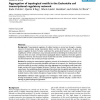Free Online Productivity Tools
i2Speak
i2Symbol
i2OCR
iTex2Img
iWeb2Print
iWeb2Shot
i2Type
iPdf2Split
iPdf2Merge
i2Bopomofo
i2Arabic
i2Style
i2Image
i2PDF
iLatex2Rtf
Sci2ools
BMCBI
2004
2004
Aggregation of topological motifs in the Escherichia coli transcriptional regulatory network
Background: Transcriptional regulation of cellular functions is carried out through a complex network of interactions among transcription factors and the promoter regions of genes and operons regulated by them.To better understand the system-level function of such networks simplification of their architecture was previously achieved by identifying the motifs present in the network, which are small, overrepresented, topologically distinct regulatory interaction patterns (subgraphs). However, the interaction of such motifs with each other, and their form of integration into the full network has not been previously examined. Results: By studying the transcriptional regulatory network of the bacterium, Escherichia coli, we demonstrate that the two previously identified motif types in the network (i.e., feed-forward loops and bi-fan motifs) do not exist in isolation, but rather aggregate into homologous motif clusters that largely overlap with known biological functions. Moreover, these cl...
| Added | 16 Dec 2010 |
| Updated | 16 Dec 2010 |
| Type | Journal |
| Year | 2004 |
| Where | BMCBI |
| Authors | Radu Dobrin, Qasim K. Beg, Albert-László Barabási, Zoltán N. Oltvai |
Comments (0)

